Welcome to our article on Rotala Nanjenshan, a stunning aquatic plant that has captured the hearts and imaginations of aquascapes around the world.
In this blog post, we will dive into the mesmerizing world of Rotala Nanjenshan, exploring its rich history, optimal conditions for growth, care and maintenance tips, propagation techniques, and more.
Whether you’re a seasoned aquascaper or just starting out, join us on this journey as we uncover the secrets behind the beauty of Rotala Nanjenshan and discover how it can elevate your aquascape to new heights.
Key Takeaway
- Rotala Nanjenshan is a sought-after aquatic plant known for its vibrant colors and beauty in aquascaping.
- It belongs to the Lythraceae family and hails from the Nanjenshan Mountain in Taiwan.
- Rotala Nanjenshan has gained immense popularity among aquascapers due to its striking foliage, compact growth, and versatility in design.
- Providing optimal conditions such as lighting, pH, temperature, and water hardness is crucial for the healthy growth of Rotala Nanjenshan.
- Regular trimming, proper care, and nutrient supply are essential to maintain the plant’s appearance and ensure its lush growth.
Quick Stats
| Attribute | Details |
| Family Name | Lythraceae |
| Origin | Southeast Asia, specifically Taiwan |
| Height | 20-40 cm (8-16 inches) |
| pH Range | 6.0 – 7.5 |
| CO2 Requirement | Moderate to High |
| Growth Rate | Moderate to Fast |
| Care Level | Moderate |
| Color Form | Vibrant green and pink hues |
| Water Conditions | 22-28°C (72-82°F), soft to moderately hard water |
| Max Size | Forms dense clusters, typically not exceeding 20-40 cm (8-16 inches) in height |
| Lighting | Moderate to High |
| Supplements | Requires nutrient-rich substrate and regular liquid fertilization |
| Placement | Mid-ground to Background |
| Propagation | Stem cuttings or replanting trimmings |
What Is Rotala Nanjenshan?
Rotala Nanjenshan is a species of aquatic plant that belongs to the Lythraceae family.
It is native to the Nanjenshan Mountain in Taiwan, where it was first discovered.
In recent years, Rotala Nanjenshan has gained immense popularity among aquascapers for its unique and attractive features.
Its vibrant red and green foliage, compact growth pattern, and versatility in aquascape designs make it a highly desirable plant for both beginners and experienced aquascapers.
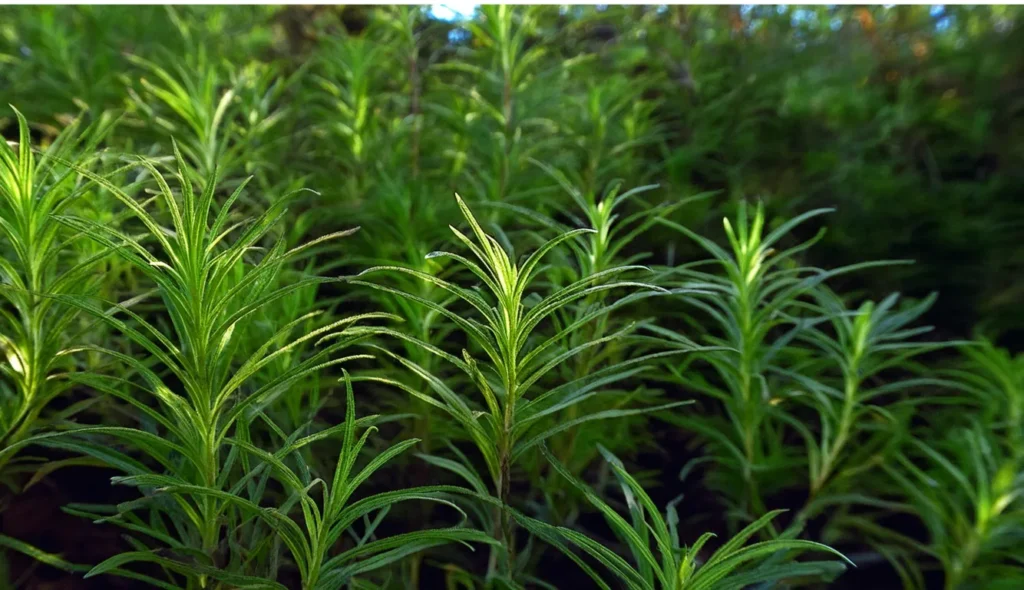
Characteristics That Make Rotala Nanjenshan Desirable
Rotala Nanjenshan possesses several characteristics that make it highly desirable among aquascapers:
- Vibrant Colors: Rotala Nanjenshan’s colorful foliage, with its vivid red and green hues, adds a captivating visual element to any aquascape.
- Compact Growth Pattern: This plant tends to grow compact and bushy, making it suitable for foreground and midground placements in aquarium layouts.
- Versatility: Rotala Nanjenshan is incredibly versatile, allowing aquascapers to experiment with various aquascaping styles and layouts. It can be utilized as an accent plant, centerpiece, or background plant, depending on the desired effect.
- Easy to Care For: Despite its stunning appearance, Rotala Nanjenshan is relatively easy to care for, making it an ideal choice for both beginner and experienced aquascapers.
History
The history of Rotala Nanjenshan is deeply rooted in its discovery on the picturesque Nanjenshan Mountain in Taiwan.
Plant enthusiasts were captivated by the plant’s striking beauty and uniqueness, leading to its introduction to the aquascaping community.
Since its introduction, Rotala Nanjenshan has gained widespread recognition for its ability to flourish in aquatic environments, captivating the hearts of aquascapers worldwide.
Aquascapers have embraced the beauty of Rotala Nanjenshan and harnessed its potential for creativity and innovation.
Through careful experimentation, they have developed new techniques and layouts, pushing the boundaries of aquascape design.
The history of Rotala Nanjenshan is an inspiring journey of discovery, transformation, and the pursuit of creating breathtaking aquascapes.
Lighting Requirements And Intensity Levels For Growth
Rotala Nanjenshan thrives under moderate to high lighting conditions, with an intensity level of around 2-3 watts per gallon.
Sufficient lighting is crucial for photosynthesis, enabling the plant to convert light energy into chemical energy.
Adequate light promotes vibrant coloration and compact growth in Rotala Nanjenshan, elevating its visual appeal in your aquascape.
RELATED: Echinodorus Red Flame To Aesthetically Design Your Aquarium

Water Parameters
- Rotala Nanjenshan prefers a pH range of 6.0-7.5, which is slightly acidic to neutral. Maintaining the appropriate pH level ensures optimal nutrient uptake, allowing the plant to thrive and flourish.
- In terms of temperature, Rotala Nanjenshan thrives in a range of 72-82°F, replicating its natural habitat in tropical environments. Additionally, the water hardness should be in the range of 3-8 dKH (degrees of carbonate hardness), which supports healthy growth and prevents the softening of the plant’s cell wall structure.
Temperature Parameter For Optimal Growth
- Metabolic Rate: Warmer temperatures within the specified range generally lead to increased metabolic rates in plants. This means that Rotala Nanjenshan can carry out essential physiological functions more efficiently, promoting robust growth.
- Photosynthesis: Temperature affects the rate of photosynthesis in aquatic plants. Within the optimal range, Rotala Nanjenshan can efficiently utilize light energy to convert carbon dioxide and water into oxygen and glucose, which fuels growth and development.
- Nutrient Uptake: Temperature influences nutrient uptake and assimilation in plants. Within the optimal range, Rotala Nanjenshan can absorb essential nutrients from the water and substrate more effectively, supporting healthy growth and vibrant coloration.
- Disease Resistance: Maintaining the optimal temperature range helps bolster the plant’s immune system and resistance to diseases and pests. Extreme temperature fluctuations or prolonged exposure to temperatures outside the ideal range can weaken the plant and make it more susceptible to stressors.
Substrate Requirement
- Nutrient-Rich Substrate: Choose a substrate that is rich in nutrients to provide a solid foundation for Rotala Nanjenshan’s root system. Substrates specifically designed for planted aquariums, such as nutrient-rich plant substrates or aquasoils, are excellent options. These substrates typically contain essential nutrients like nitrogen, phosphorus, and potassium, as well as trace elements that support plant growth.
- Fine-Grained Substrate: Rotala Nanjenshan has delicate roots, so a fine-grained substrate can be beneficial. Fine substrates, such as sand or fine gravel, allow the roots to spread easily and anchor the plant securely. Avoid coarse substrates that may damage the roots or impede root growth.
- Depth: Aim for a substrate depth of at least 2 to 3 inches (5 to 7.5 cm) to provide ample space for root development. Deeper substrates can accommodate longer root systems and help stabilize the plants, especially in taller aquariums.
- Substrate Additives: Consider adding substrate additives like root tabs or nutrient-rich capsules to supplement the substrate with additional nutrients. These additives can provide a localized nutrient boost around the roots of Rotala Nanjenshan, promoting healthy growth and vibrant coloration.
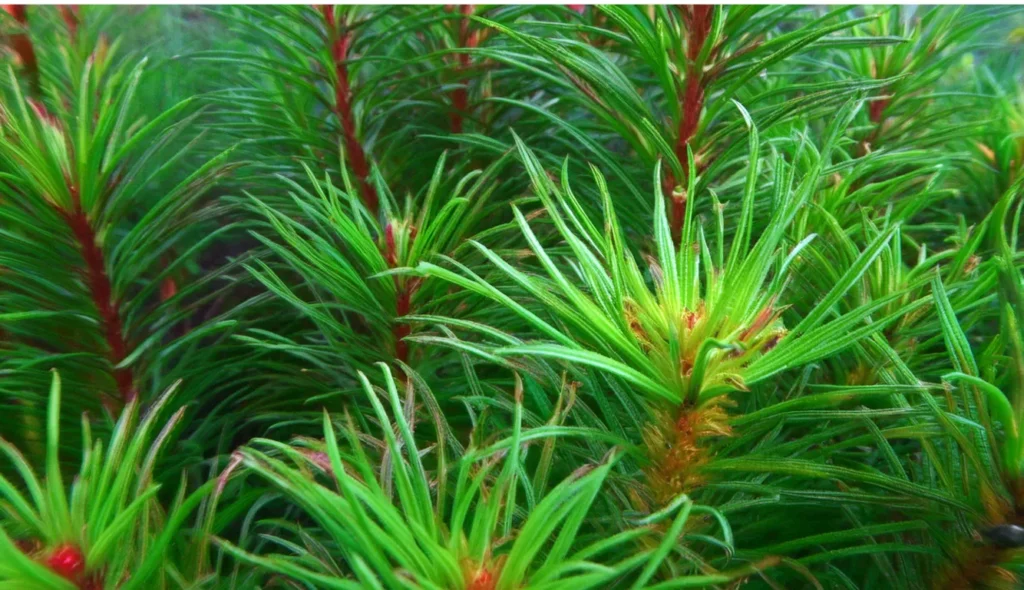
Placement Option
- Background Planting: Rotala Nanjenshan can be placed in the background of your aquarium to create a lush green backdrop. Plant taller stems behind shorter plants or hardscape elements to add depth to your aquascape. This placement option works well for showcasing the plant’s vibrant foliage and creating a naturalistic underwater scene.
- Midground Accent: Rotala Nanjenshan can also be used as a midground accent plant to add visual interest to the middle portion of your aquarium. Plant it alongside other midground plants or in between hardscape features to create focal points and break up open spaces. This placement option helps to balance the overall composition of your aquascape and draws the viewer’s eye towards the center of the tank.
- Foreground Planting: While Rotala Nanjenshan is typically used as a background or midground plant, shorter stems or trimmed stems can be planted in the foreground of your aquarium. This can create a dynamic transition between different planting zones and add depth to the overall layout. Be mindful of the plant’s growth habit and ensure that it does not overshadow smaller foreground plants.
- Floating Plant: In some cases, Rotala Nanjenshan stems can be allowed to float near the surface of the water. This placement option can create a naturalistic appearance and provide cover for surface-dwelling fish or fry. However, be aware that floating stems may require regular maintenance to prevent them from obstructing light or spreading excessively.
Recommended Tank Size
- Small Tanks: Rotala Nanjenshan can be grown in smaller aquariums, such as nano tanks or tanks with capacities ranging from 5 to 20 gallons. In smaller tanks, you may need to trim and manage the plant more frequently to prevent overcrowding and maintain an aesthetically pleasing appearance.
- Medium Tanks: For medium-sized aquariums, ranging from 20 to 50 gallons, Rotala Nanjenshan can be used as a background or midground plant. Its vibrant green foliage can add depth and color to the aquascape without overpowering smaller plants or fish.
- Large Tanks: In larger aquariums, exceeding 50 gallons in capacity, Rotala Nanjenshan can be planted in greater quantities to create lush, dense backgrounds or focal points. Larger tanks provide more space for the plants to grow and spread, allowing for impressive displays of foliage.
- Aquascape Design: Consider the overall design and layout of your aquascape when selecting the tank size. Rotala Nanjenshan can be used to create striking vertical accents, fill in empty spaces, or create dense background plantings, depending on your preferences and the size of your tank.
- Compatibility: Take into account the needs and compatibility of other tank inhabitants, such as fish, shrimp, and snails. Ensure that the tank size can accommodate the needs of both the plants and the animals, providing ample space and suitable environmental conditions for all inhabitants.
Suitable Tank Size
- Planting Density: Rotala Nanjenshan can be planted densely to create a lush background or midground in your aquarium. Consider how many stems you want to include and how densely you want to plant them. Larger tanks provide more space for dense plantings without overcrowding.
- Aquascape Design: Think about the overall layout and design of your aquascape. Rotala Nanjenshan can be used as a background plant, midground accent, or even a foreground plant if trimmed appropriately. Choose a tank size that allows you to create the desired layout and achieve the visual effect you’re aiming for.
- Tank Inhabitants: Consider the needs and compatibility of other tank inhabitants, such as fish, shrimp, and snails. Make sure the tank size is suitable for both the plants and the animals, providing enough space and suitable environmental conditions for all inhabitants to thrive.
- Maintenance: Larger tanks generally require less frequent maintenance compared to smaller tanks. Consider your ability to maintain water parameters, perform routine maintenance tasks, and trim and manage the plants as they grow. Choose a tank size that fits your maintenance routine and time availability.
- Aquarium Equipment: Take into account the size and placement of aquarium equipment, such as filters, heaters, and lighting fixtures. Make sure the tank size accommodates the necessary equipment and allows for proper circulation, filtration, and lighting to support plant growth.

Nutritional Needs
Rotala Nanjenshan, like all aquatic plants, requires several key nutrients to support healthy growth and development. These nutrients can be broadly categorized into macronutrients and micronutrients.
Macronutrients
- Nitrogen (N): Nitrogen is a crucial component of chlorophyll, the pigment responsible for photosynthesis. It’s essential for overall plant growth and protein synthesis.
- Phosphorus (P): Phosphorus is necessary for energy transfer within the plant and is vital for processes such as photosynthesis, respiration, and cell division.
- Potassium (K): Potassium plays a key role in enzyme activation, osmoregulation, and maintaining turgor pressure in plant cells. It’s essential for overall plant health and stress tolerance.
Secondary Nutrients
- Calcium (Ca): Calcium contributes to cell wall structure and stability, as well as nutrient uptake and transport within the plant.
- Magnesium (Mg): Magnesium is a central component of chlorophyll molecules and is involved in photosynthesis. It also plays a role in enzyme activation and energy metabolism.
Micronutrients (Trace Elements)
- Iron (Fe): Iron is essential for chlorophyll synthesis and is involved in electron transport during photosynthesis. Iron deficiency can lead to chlorosis (yellowing of leaves).
- Manganese (Mn), Zinc (Zn), Copper (Cu), Boron (B), Molybdenum (Mo), and Chlorine (Cl): These micronutrients are required in smaller quantities but are essential for various metabolic processes within the plant, including enzyme activation and hormone synthesis.
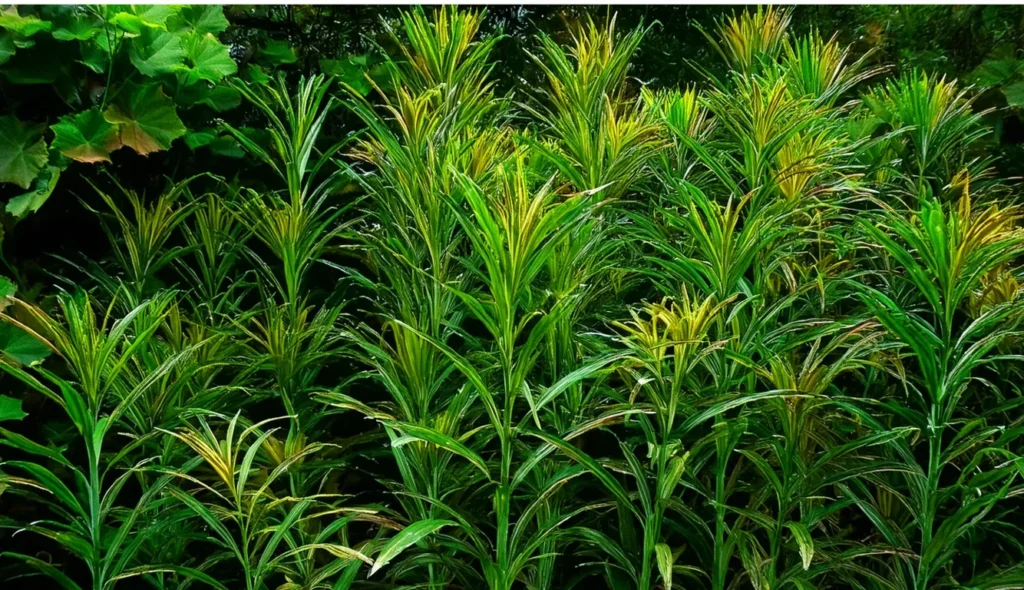
Rotala Nanjenshan Cultivation Tips
- Lighting: Provide moderate to high lighting levels for Rotala Nanjenshan. This plant thrives under bright light, which promotes healthy growth and vibrant coloration. LED lights designed for planted aquariums are ideal for providing the necessary intensity and spectrum for optimal plant growth.
- CO2 Injection: Consider supplementing carbon dioxide (CO2) in your aquarium, especially in setups with higher lighting levels. CO2 supplementation can enhance photosynthesis and promote robust growth in Rotala Nanjenshan. However, it’s essential to monitor CO2 levels and avoid overdosing, as excessive CO2 can harm fish and other aquatic inhabitants.
- Nutrient Supplementation: Provide a balanced fertilization regimen to ensure that Rotala Nanjenshan receives essential nutrients for healthy growth. Use a liquid fertilizer or root tabs to supplement macronutrients (nitrogen, phosphorus, potassium) and micronutrients (iron, manganese, etc.). Adjust the fertilization schedule based on plant growth and water parameters.
- Substrate: Plant Rotala Nanjenshan in a nutrient-rich substrate to support root development and nutrient uptake. Fine-grained substrates such as aquasoil or nutrient-rich planting substrates are suitable options. Ensure adequate substrate depth (2-3 inches) to accommodate root growth.
- Trimming and Pruning: Regularly trim Rotala Nanjenshan stems to promote bushy growth and prevent overcrowding. Use sharp scissors to trim the stems just above a leaf node. This encourages lateral branching and creates a denser, more attractive appearance. Trimmed cuttings can be replanted to propagate new plants.
Plant Propagation Tips
- Select Healthy Stems: Choose healthy and vibrant stems for propagation. Avoid stems that show signs of disease, damage, or nutrient deficiencies. Healthy stems will have lush foliage and strong growth.
- Take Stem Cuttings: Using sharp, clean scissors or aquascaping tools, cut a portion of the stem from the parent plant. Make the cut just below a leaf node, ensuring that each cutting is approximately 2 to 4 inches (5 to 10 cm) in length. Each cutting should have at least one or two leaf nodes.
- Trim Leaves: Trim any leaves from the bottom portion of the cutting that will be planted in the substrate. Leave a few leaves at the top of the cutting to continue photosynthesis and support the plant during rooting.
- Plant the Cuttings: Plant the stem cuttings in the substrate, burying the trimmed end securely. Insert the cuttings at an angle to encourage new growth and prevent them from floating away. You can plant multiple cuttings close together to create a dense grouping.
- Provide Optimal Conditions: Ensure that the newly planted cuttings receive optimal conditions for rooting and growth. This includes providing adequate lighting, nutrient supplementation, and carbon dioxide (CO2) if available. Maintain stable water parameters and good water circulation around the cuttings.
RELATED: A Guide To Cultivate Eleocharis Parvula (Dwarf Hairgrass) At Home
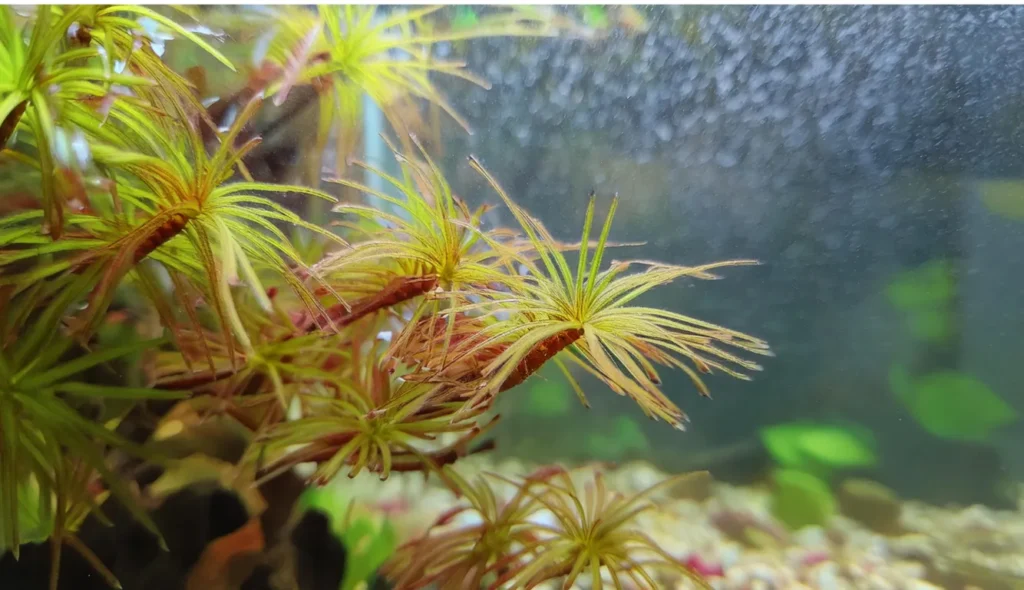
Benefits Of Rotala Nanjenshan
- Water Filtration: Like all aquatic plants, Rotala Nanjenshan helps to naturally filter the water in your aquarium by absorbing excess nutrients such as nitrates and phosphates. This can help to maintain water quality and reduce the risk of algae blooms, creating a healthier environment for fish and other aquatic inhabitants.
- Oxygenation: During photosynthesis, Rotala Nanjenshan absorbs carbon dioxide and releases oxygen into the water. This process helps to oxygenate the aquarium, providing vital respiratory support for fish, shrimp, and other aquatic organisms.
- Algae Control: By competing with algae for nutrients and light, Rotala Nanjenshan can help to inhibit the growth of unwanted algae in your aquarium. The dense growth of Rotala Nanjenshan can shade the substrate and create competition for resources, reducing the likelihood of algae outbreaks.
- Aquascape Enhancement: Rotala Nanjenshan adds visual interest and vibrant green coloration to your aquascape. Its slender stems and delicate leaves create a graceful, natural appearance that complements a variety of aquarium designs. Whether used as a background plant, midground accent, or focal point, Rotala Nanjenshan can enhance the beauty of your underwater landscape.
Common Issues And Remedies In Rotala Care
- Despite our best efforts, Rotala Nanjenshan may encounter common issues that require attention and remedies. Nutrient deficiencies can manifest as stunted growth, pale or yellowing leaves, or curled leaf edges. To address these deficiencies, adjusting fertilization practices by increasing the dosage of specific nutrients or using comprehensive fertilizers can help resolve the issue.
- Algae growth is another common issue in Rotala Nanjenshan tanks, which can be attributed to nutrient imbalances, excess light, or poor water quality. Regular water changes, limiting the duration and intensity of light exposure, and maintaining a healthy balance of nutrients can help keep algae growth under control. Additionally, employing algae-eating fish or shrimp species can provide natural methods of algae control.
- Pest infestations, such as snails or aphids, can also occur in Rotala Nanjenshan tanks. Manual removal of pests and implementing preventative measures, such as quarantining new plants and maintaining good tank hygiene, can help manage infestations. If necessary, specific treatments targeted at the particular pest can be employed.
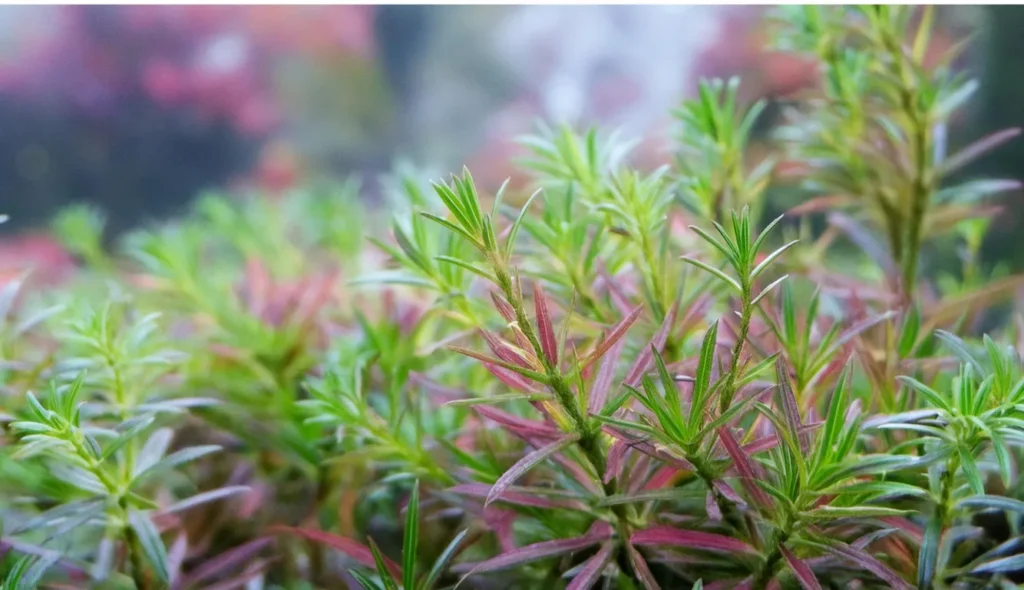
Conclusion
Rotala Nanjenshan is a remarkable aquatic plant that adds beauty, vibrancy, and dimension to aquascapes.
Its unique features and stunning aesthetics have made it increasingly popular among aquascapers.
By providing optimal growing conditions, implementing proper care and maintenance techniques, and incorporating Rotala Nanjenshan into creative aquascape layouts, you can create captivating underwater landscapes that showcase the true beauty of this plant.
To ensure the healthy growth of Rotala Nanjenshan, it is essential to provide moderate to high lighting, maintain the appropriate water parameters, and supply the necessary nutrients.
Regular trimming and pruning will help to maintain its compact and bushy form, while proper fertilization and addressing common issues will ensure its well-being.
Frequently Asked Questions
How Important Are Trimming And Pruning For Maintaining Rotala Nanjenshan?
Regular trimming and pruning are crucial for maintaining the health and appearance of Rotala Nanjenshan in an aquascape.
It helps prevent overgrowth and ensures a compact and bushy form.
What Are The Nutrient Requirements For Nurturing Healthy Growth In Rotala Nanjenshan?
Rotala Nanjenshan requires a balanced supply of macronutrients and micronutrients, including nitrogen, phosphorus, potassium, iron, and trace elements.
Fertilizers can be added through substrate fertilization, liquid fertilization, or CO2 injection.
How Can Rotala Nanjenshan Be Propagated?
Rotala Nanjenshan can be propagated by clipping healthy stems and replanting them in suitable conditions.
CO2 injection is often recommended to enhance the growth and establishment of new plants.
How Can Rotala Nanjenshan Be Incorporated Into Aquascape Layouts?
Rotala Nanjenshan can be used as a foreground or midground plant, adding vibrant color, texture, and height to the overall design.
It pairs well with various other aquatic plants and peaceful tank mates like small fish and shrimp species.
What Can Be Learned From A Case Study About Rotala Nanjenshan In An Aquascaping Journal?
A case study in an aquascaping journal provides insights into the care, growth patterns, and long-term maintenance of Rotala Nanjenshan based on the experiences of experienced aquascapers.
- Unveiling The Wonders Of Riccia Fluitans In Aquascapes - August 7, 2024
- Vallisneria Gigantea Var. Guide To Care And Cultivation At Home - July 31, 2024
- Vesicularia Dubyana Care & Growth Guide Tips For Beginner Gardeners - July 30, 2024
